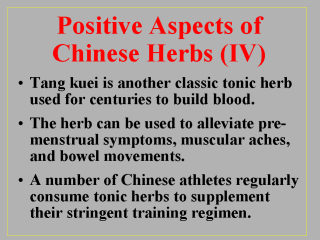| front |1 |2 |3 |4 |5 |6 |7 |8 |9 |10 |11 |12 |13 |14 |15 |16 |17 |18 |19 |20 |21 |22 |23 |review |
 |
Tang kuei (also
pronounced as dong quai or dang gui) is another well known classic tonic
herb used in China for centuries. Even though the taste is quite acrid to some people,
tang kuei is a rich source of B vitamins, calcium, iron, magnesium, and essential oils.
Studies indicate that many of these nutrients are enhancers in the blood-building process,
especially when coupled with nutrients from other foods (e.g., chicken, beef, etc.). This
is why tang kuei is famous for its popular use by child-bearing women, since they lose
blood regularly and need to replenish it constantly. In addition to the relief of pre-menstrual symptoms (e.g., Bensky and Gamble, 1993), tang kuei is often used for the purposes of alleviating muscular aches and bowel movements. It has been used in combination with some other tonic herbs including ginseng. The common English name of tang kuei is Angelica sinensis. Like ginseng, only the root of this plant is used for the tonic properties mentioned above. It has been said that many great Chinese athletes, including those who shattered several world records, supplement their stringent training regimen with regular consumption of one or more tonic herbs such as ginseng, huang qi, or tang kuei. For a further understanding of Chinese tonic herbalism in the English literature, students are referred to the recent book by Teeguarden (2000), entitled The Ancient Wisdom of the Chinese Tonic Herbs. |